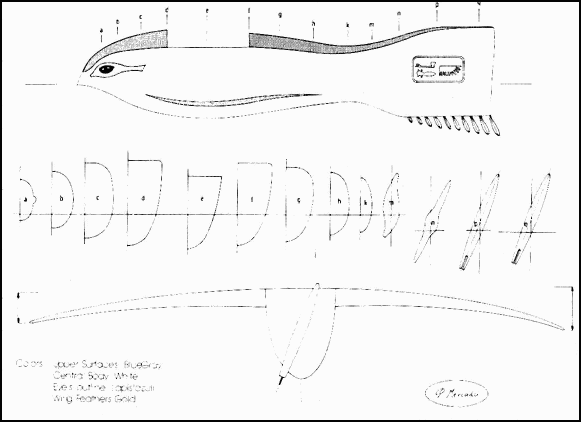
© Drawing copyright Paula Mercado
From AeroPlans for the creative modeler and aviation historian, Issue #2, Winter/Spring, 1990:
Was this ancient Egyptian model a boomerang, toy, symbol or?... We'll probably never know. We do know the Egyptians were great seekers after knowledge. Also skilled falconers. The highly detailed drawings and notes of artist PAULA MERCADO certainly raises provocative questions about this mysterious artifact.

© Drawing copyright Paula Mercado
Among the varied archaeological remains showed to me during my visit to the Egyptian Museum of Antiquities, there was an object which really struck me. it was something very similar to the airplane models we loved to fly in our childhood. It was, undoubtedly, a monoplane made from sycamore wood, weighing about 39 grms. It had been dated circa 200 BC and was found in Sakkara in 1898.The truth is that this is not the only winged object found among the different tools and artistic expressions from the Ancient Egypt. There are winged beetles from the Greek-Roman period, representations of some deities (Horus/Ra) were symbolized by a hawk with the sun over its head - and four high-relief unknown winged deities on the four squares of the Tuk-Ankh-Amen's quartz sarcophagus (still containing his mummy in the Death's Valley tomb).
Might we really think that the Egyptian civilization reached such greatness as to develop basic flying essentials? The fact is the object exists and is formed of two different parts: --
- The wing is one piece of wood and with asymmetric shape to get Boomerang effect flights. Not only one of them is shorter than the other, but also the negative dihedral angle is more marked.
- The body, one piece too, has a peak-of-a-bird shape (falcon) with an eye both sides. These eyes are the polished extremes of an obsidian bar which, crossing the head from one side to the other, counterbalances the plane. It seems the Egyptians painted eyes on the forward part of their vehicles in the believing that this would help them to find the right route.

© Drawing copyright Paula Mercado
The central body's thickness grows from the nose backwards until getting to its joining point with the wing (the thickest point) from where it begins to thin gradually again until the tail, which is turned down towards one of the sides to help the plane making gyros. With an almost rectangular shape, this tail has an Egyptian inscription, "chi" (one of three ideographic symbols to express the flying concept) and several feathers, mounted in a series of holes from larger to shorter, for the purpose of a periodical renewal. Surely they tried to compel more "flying spirit" to the object. Same purpose should have the feathers painted over the wing.Colors:
- Upper Surfaces: BlueGray
- Central Body: White
- Eye's outline: LapisLazuli
- Wing Feathers: Gold
There are also a couple of red stripes on both sides of the central body.
AeroPlans © copyright Andrew C. Anson
Catchpenny Mysteries © copyright 2001 by Larry Orcutt.